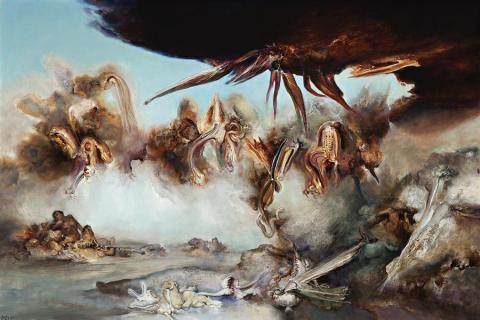RELUCTANT ADAM, 1996
JAMES GLEESON
oil on canvas
134.0 x 200.0 cm
signed and dated lower left: Gleeson '96
signed, dated and inscribed verso: “RELUCTANT ADAM” /'96 James Gleeson
Gleeson O'Keefe Foundation, Sydney
Sotheby's Australia, Sydney, 31 August 2010, lot 30 (label attached verso)
Private company collection, Sydney
James Gleeson: Behind the Veil of Seeming, Watters Gallery, Sydney, 12 – 29 November 1997, cat. 8 (illus. in exhibition catalogue) (label attached verso)
'As human beings we do not have the capacity to imagine the unimaginable. We can only project from a basis of the unknown.' 1
James Gleeson melds the familiar with the curious and unusual, and concocts an inescapable world of uncertainty. He guides his viewer to an alternative reality by 'bringing together pre-existing realities in such new relationships as might surprise us into feeling that we have caught a momentary glimpse of something that had previously been hidden from us.'2
In his early travels to Europe in the late 1940s, Gleeson was inspired by the Renaissance painters and sculptors, and in particular, works by Michelangelo and his creation of the perfect image of man. He was moved by The Creation of Adam on the vast ceiling of the Sistine Chapel in Italy. Gleeson's Reluctant Adam, 1996 illustrates a nebulous version of Michelangelo's work, utilising a classic image of art history to infuse his subtle social critiques. The image of the unwilling man was no longer perfect and almost dissolving into the rocks, and the image of God reaching out to Adam had morphed to a crustacean cloaked by an ominous dark cloud. Adam appears unenthusiastic and almost loathing.The looming stretch of limb mimics Michelangelo's impression of God outstretching his hand to Adam as a symbol of breathing life to mankind, but the once idealised imagery of man and God (in the image of a perfect man) no longer exists and has morphed into extraordinary beings and ideals.
Gleeson's mutated impression of Michelangelo's God and angels, and the ethereal fluidity of his landscape was further inspired by his excursions to coastal Queensland. He was fascinated by the sea, rock pools and the creatures that inhabited the intertidal zone on Peregian Beach, where he spent a summer holiday in December 1982 - January 1983. The creatures he observed there became significant elements in his later works. In Reluctant Adam, Gleeson has created a series of floating obscure squid-like beings and has dominated the canvas with a large crustacean hovering amongst the clouds. Gleeson reflects,'One of the most important and constantly recurring motifs throughout my work is based on a sense of the mutability of all forms and substances. Metamorphosis has always been, for me, one of the basic facts of life. Everything takes on a form, changes, falls apart and reforms in new organisations in an endless cycle.'3
1. Gleeson, cited in Free, R., James Gleeson: Images from the Shadows, Craftsman House, Sydney, 1993, p. 42
2. Ibid.
3. Gleeson, J., quoted in, 'James Gleeson', National Portrait Gallery, Canberra, viewed 17 June 2015 <http://www.portrait.gov.au/people/james-gleeson-1915>
